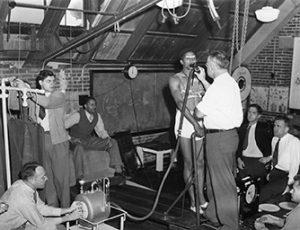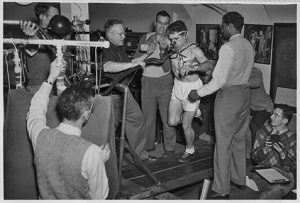
Located in Huff Hall, the Physical Fitness Research Laboratory was the site of pioneering research that introduced science into physical education, with focuses on conditioning and development, athletic performance, and general health.
The laboratory was founded by Professor Thomas K. Cureton in 1944, and directed by him until his retirement in 1969. Designed as a teaching-research facility, Dr. Cureton’s general goals for the lab included:
- Increasing scientific understanding of the work productivity of the human body through fitness tests of endurance, flexibility, agility, strength, power, and balance, which he called the six primary components of physical fitness
- Developing normative standards for each test for men, women, and children
- Diagnosing physical condition based on test results
- Prescribing and providing leadership for conditioning exercises

Through his research, Dr. Cureton hoped to:
- Improve physical fitness
- Improve circulatory function
- Improve endurance
- Improve proportions of bone-muscle-fat
- Improve physical fitness of youth
- Develop best ways to train and test athletes
- Discover new instruments and tools and simplified methods of testing physical fitness
Dr. Cureton, his students, and research associates systematically investigated many aspects of fitness, among them:
- the effects of endurance exercises and physical training on weight, fat, metabolism, tissue proportions, and cardiovascular condition
- the effects of regular exercise on sedentary adults
- anatomical, physiological, and psychological aspects of physical performance
- the relationship between endurance and cardiovascular-respiratory fitness

Pioneering Research
- Early research on weight and tissue symmetry analyses looking at bone, muscle, and fat separately—Dr. Cureton was one of the first to argue that weight alone meant very little unless it is differentiated into tissue components
- First of its kind study of the effects of ultraviolet radiation on physical fitness—Dr. Cureton discovered that UV exposure produced significant gains in cardiovascular fitness and muscular endurance
- Physical Fitness Appraisal and Guidance, published in 1947 and based on research in the Physical Fitness Research Laboratory, is considered his most important book—it outlined new cardiovascular parameters for exercise and reported findings from research using his adaptation of the Heartometer, which recorded the action of the heart and measured blood pressure. He was the first to use the Heartometer to monitor subjects during fitness tests. Dr. Cureton standardized the methods of quantification of the Heartometer’s output and evaluated the validity of the graphs for predicting physical endurance performances.
- Comprehensive studies of 1948 Olympic gymnasts, swimmers, and track and field athletes to identify unique factors related to athletic success—in this body of research, Dr. Cureton conducted the first studies of oxygen intake within a controlled, even-paced, all-out treadmill test
- Early studies that showed swimming greatly improved fitness in adults
- Cureton created adult fitness scoring tables, including measures of fat, ability to hold breath after exercise, cardiovascular health, and physical endurance performance.
- His article “Physical Fitness Improvements of a Middle-Aged Man” published in Research Quarterly in 1952, was one of the first articles to stress exercise in the medical literature.
- Cureton’s research that showed positive effects of physical training on the cardiovascular and respiratory systems pre-dated the medical establishment’s acceptance of exercise’s role in heart health by approximately 15 years. His was some of the earliest research relating exercise to the reductions of fat, cholesterol, triglycerides, and phospholipids.
- Cureton and his graduate students did some of the first work in physical education that used multichannel recordings of brachial and carotid pulse waves, electrocardiograms (ECG or EKG), and ballistocardiograms
- Cureton’s research in the Physical Fitness Research Laboratory led to the development of many new tests, including the Cureton Muscular Endurance Test, the Cureton Test of Swimming Endurance, the Illinois 14-Item Motor Fitness Test, the Cureton All-Out Treadmill Run Test, the Cureton-Illinois Motor Fitness Test, and the Cureton Flexibility Test.

Under the direction of Dr. Thomas K. Cureton, the Physical Fitness Research Laboratory at the University of Illinois became the most prestigious exercise physiology research laboratory of its time. The research that came out of the lab changed not only the direction of physical education for youth, but also approaches to training for elite athletes and physical fitness conditioning programs for the general population.
The reputation of the physical education field was elevated and research laboratories were founded in many other physical education departments because of the scientific approach to exercise physiology taken in the lab. Its research led to significant shifts in thinking about fitness at all stages of life and of the role and nature of exercise in developing physical fitness.
Huff Hall. This was where the Physical Fitness Research Laboratory was located.
“All-Out” Experiment. (1947). Thomas K. Cureton, Jr. Papers 1930-1992. Record Series 16/3/21, Box 12, Folder Laboratory Photographs. University of Illinois Archives
Berryman, J. W. (1996). Thomas K. Cureton, Jr.: Pioneer Researcher, Proselytizer, and Proponent of Physical Fitness. Research Quarterly for Exercise and Sport, 67(1), 1-12. . DOI: 10.1080/02701367.1996.10607920
Bicycle Ergometer. (ca. 1950s). Photographic Subject File, 1868-. Record Series 39/2/20, Box 166, PHE-2, 1946-65. University of Illinois Archives.
Cameron Heartometer Corporation (n.d.). Cameron Heartometer Company: A History. Retrieved from www.cameronville.com/crofts/tom-kari/cameron/chc/history.html
Ciolcosz, R. (2017). Thomas K. Cureton: The Father of Physical Fitness. The University of Illinois: Engine of Innovation. Champaign: University of Illinois Press.
Cureton Experiments Using Treadmill. (1964). Thomas K. Cureton, Jr. Papers, 1930-1992. Record Series 16/3/21, Box 12, Folder Laboratory Photographs. University of Illinois Archives.
Cureton Measures Heart Stroke Volume and Oxygen Intake. (ca. 1960s-1970s). Thomas K. Cureton, Jr. Papers, 1930-1992. Record Series 16/3/21, Box 12, Folder Laboratory Photographs. University of Illinois Archives.
Cureton, T. K. (1963). Review of Studies to Improve Cardiovascular Fitness at the Physical Fitness Research Laboratory 1941-1963. From Thomas K. Cureton Jr. Papers, 1930-1992. Record Series 16/3/21, Box 3. University of Illinois Archives.
Cureton, T. K. (1963). Review of Studies to Improve Fitness at the Physical Fitness Research Laboratory 1941-1963. From Thomas K. Cureton Jr. Papers, 1930-1992. Record Series 16/3/21, Box 3. University of Illinois Archives.
